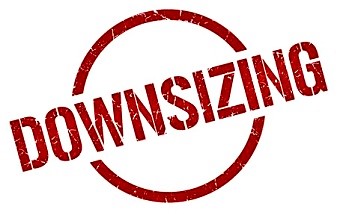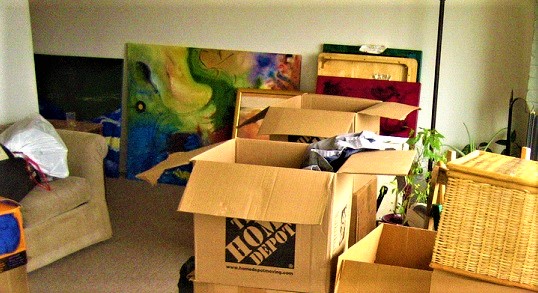
Learn How To Home Downsize For FREE
Join Professional Home Organizer, Caralyn Kempner For A FREE Virtual Home Organizing & Downsizing Webinar:
October 13th, at 7:00 pm CST
Sponsored by The South Holland Public Library
October 26th, at 6:30 pm CST
Sponsored by The Villa Park Public Library
Top 7 Downsizing Strategies
Moving into a new home is exciting and stressful at the same time — tension mounds when we have also need to reduce our possessions.
Older adults and the millennial population (born between 1981-1996) share similar desires to live in conservative space or downsize, declutter, and reduce finances.
Money, time, and minimalism are the motivation fueling the global trend of downsizing. Taxes, insurance, utilities, maintenance, and decorating increase per living square feet. Taking time for household upkeep, whether done by ourselves or hiring, consumes a big chunk of our time and usually occupies our weekends and other free time. Millennials and seniors alike are the demographic groups that want their time spent on relaxation, entertainment, or relationships over space. There is also another factor driving the downsizing trend: a shifting mindset that says that less might be more. The “declutter and simplify” movement has gained considerable momentum of late.
Although sharing the same desires for simpler living, the seniors have more work on their plates to obtain this lifestyle than the millennials because they usually face a reduction process of their belongings.
When you need to downsize your possessions because you are moving to a smaller environment, consider that the percentage of space lost would equal the percentage amount of stuff you need to shed. For example, moving out of a 2,200 square foot home and into 1,200 square foot space is half the space. Theoretically, half of your items would need to go. It is necessary to go about a realistic reducing process. Keeping the majority of your stuff will cost you money in packaging and moving expenses. Furthermore, the volume of belongings will overwhelm your new space and create future stress.
The following are the top 7 decluttering strategies that can help you in the downsizing process.

Start the downsizing process at least a year in advance.
A year is not a long time to properly reduce decades of belongings. You want enough time to think through your stuff so you don’t end up giving your items away in a quick yard sale or making short-sighted decisions getting rid of things you actually could use. Think about all the things you need to declutter when you move to a new place-electronics, papers, clothing, board games, dishes, china, furniture, and so on.

Sell expensive items as soon as possible.
It is ideal to obtain the most cash for your items. The only way to do this is to have time to wait for the best offer. Also, placing your things on different selling platforms will increase the probability of a sale.
Reduce duplicates.
It is common for people to replace a small appliance to gain new features but keep the old one because it still works. Perhaps, we have guilt about getting rid of something that was in perfectly good working order. We tell ourselves that we should keep it in case the new one breaks. Commonly, such articles get tossed into our cabinets and closets where they are complete space hogs never to ignite with electricity again. There is a remote chance that these items will ever receive use. Older small appliances hold little resale value and are best donated.
We often see duplicates in home decor as well. A room gets redecorated, and we cast the old comforter, curtains, and bed skirt in the linen closet. We may feel guilty about parting with perfectly good linens even though they are out-of-style. Linen closets tend to be overcrowded spaces because they hold so many different size towels, sheets, and table linens. They also can be catch-all places for overstock paper products and toiletries. It is essential to let go of such articles because linens have poor resale value, and there is a small chance that you will revert to an outdated decor.
Digitize Paper, Music & Videos
Transferring your DVDs and CDs to a USB flash drive and saving everything to your cloud-based digital storage is a wise move beyond freeing physical storage. The benefits are endless. USB Flash drives are an easier way to store and transfer data than burning CDs and DVDs. USB flash drives are nearly infinitely rewritable, whereas DVDs are only rewritable a few times. There is also the worry of scratches and physical damage with CDs and DVDs. You can only transfer discs that do not have a copyright. Consider that you will need physical storage arrangements if you keep such discs.
It would help if you had the software and time to convert your discs onto a flash drive where you can also save the files to the cloud and hard drive because using a CD or DVD-transfer service can get expensive.
Scan and create organized digital files for your paperwork. Such projects can get overwhelming. A professional home organizer that specializes in home office organization can be a tremendous help in certain situations.
Keep hard copies of important documents such as passports and birth certificates in a fireproof safe and also make digital copies of them.
Pare down your sentimental items
We all have items either bestowed to us by a family member who passed down the clutter to you or articles that we collected on our own that hold a deeper meaning than their face value.
What you need to determine is whether you want to still hold onto them all. Often, many boxes of sentimental belongings can get pared down. Usually, we collect groups of articles that represent a specific person or event. It is necessary to go through each set of such items and determine which ones still hold an emotional value. You may be surprised that much of what you were holding onto is meaningless now.
Now is the time to finally sell the awful china that belonged to your grandmother since your kids do not like it either. When you have not had the desire to utilize your boxes of handed-down china, glassware, and the like for a decade, chances are you may never. These items are storage space hogs and need consideration for removal at this time.
Weed out the trash before you move
On a monthly basis, go through your home and remove trash using a plastic garbage bag, Remove expired OTC and prescription bottles of medication. Look for empty bottles of toiletries, old toothbrushes, worn hairbrushes and squeezed tubes of toothpaste. Recycle useless papers such as old cards, schedules, newspapers, periodicals and so on, Don’t forget the kitchen and pitch all the expired foods in the pantries and refrigerator.
Quick ways to remove unwanted items
Another person’s clutter is another’s treasure. Family and friends usually always know someone who could use your old coffee pot or linens. Take pictures of your unwanted items and email them all your contacts to see if anyone wants your stuff. It is crucial to give them a deadline to get the things and be firm about first come, first serve. Otherwise, you may be holding onto stuff too long and have a tough time remembering who gets what.
It takes a particular mindset to live successfully in a small dwelling. A millennial with a minimalist viewpoint will have a natural transition moving into little space verses a senior that is downsizing. Both will have to adapt to a more minimal lifestyle because overcrowding a tiny area with too much will lead to feelings of chaos and stress. Downsizing is challenging to do because we may not know how to declutter effectively and adjust to less. It is a process that should spread out over time because we need to properly declutter to make sure that we are dispersing unwanted items the right way and taking only the necessary things with us.
FacebookTwitterPinterestLinkedInShare
